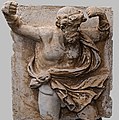Antique fist fight
The fist fight (pygme, pyx, pyxmachia, pygmahia) is a fight in which two opponents fight each other with their fists. The term fistfight is often used to distinguish the ancient fistfight from the modern fistfight, boxing .
history
The fist fight was first in the year 688 BC. Chr. Discipline at the 23rd Olympic Games of antiquity . In ancient Rome , fistfighting was mainly performed in gladiatorial fights (leather straps with metal spikes). However, it cannot be determined exactly how old the fistfight really is, as representations from ancient times ( Mesopotamia , Egypt , Crete ) show that similar fights were also fought at that time. Hands were used in the fight. The fighters tied long, leather straps ( caestus ) like a net around their hands and forearms, leaving the thumb free. On the one hand the straps should protect the hand, on the other hand they should make the blows more effective.
Competition process
It was mainly hit against the sensitive parts of the body such as teeth, ears and nose. There were no rules like today's boxing , the process of such a fight cannot be compared with today's boxing. For example, fighters were allowed to jump up and strike from above. The quick exchange of blows between the fighters often led to serious injuries, as there was no body coverage or a division of the fighters into weight classes as in today's boxing. It was not until the advancement of fighting techniques in Roman times that defensive and counter tactics were also used, on the one hand through block and on the other hand through evasive maneuvers. A fight could then last several hours. Here, with technically equivalent opponents, the physical condition was the decisive criterion for victory or defeat.
- Antique relief plates depicting two athletes in a fist fight

The fight was ended by raising the hand with an outstretched index finger as a sign of defeat. If the winner then continued to hit the loser, a referee intervened with strokes of the stick. Such scenes are known, for example, from representations on Panathenaic price amphoras . In cases where the fight was fatal, the killing fighter was punished. The sport was particularly highly regarded in ancient Greece because of its dangerousness .
Personalities
The most famous pugilist of antiquity with over 1000 prices was Theogenes of Thasos (480 BC).
Fist fight in art
There is a sitting statue of the pugilist from Quirinal in Rome from bronze . This shows consciously incorporated wounds on the face and body , as they occur in a fist fight.
Similar sports
A combined sport between wrestling and fistfighting formed the pankration in Greece . Here, however, they fought without bandages like the Caestus.
literature
- Michael B. Poliakoff: Martial arts in antiquity. The game of life and death ("Combat sports in the ancient world"). Patmos Verlag, Düsseldorf 2004, ISBN 3-491-69110-9 .
- Harold A. Harris: Sport in Greece and Rome . Thames & Hudson, London 1972, ISBN 0-500-40022-9 .
- Werner Rudolph: Olympic martial arts in antiquity. Fistfight, wrestling and pankration in the Greek National Festival (writings of the Section for Classical Studies / DAW ; Vol. 47). Akademie-Verlag, Berlin 1965.



